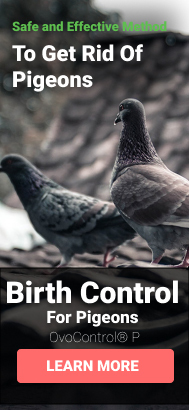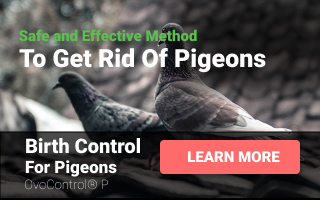Reducing Reproduction in Pigeons: A Long-Term Solution for Pigeon Control
Written by Erick Wolf
What is wrong with just killing pigeons?
There are only two ways to manage down a pigeon population:
increase mortality (kill them faster than they can breed), or,
reduce reproduction (prevent them from successfully breeding)
In the history of pigeon management, the “go-to” method has been to increase mortality. Trapping, shooting, and poisoning are all relatively inexpensive, tangible and appear to provide immediate results.
Unfortunately, despite the appearance of success, the reality is that appearances can be deceiving. Breeding up to six times a year and two eggs per clutch, pigeons breed very rapidly. Just five mating pairs can produce up to 400 pigeons in only two years. Killing them only provides temporary relief from what will become an even more rapidly expanding flock.
If even 50% of a flock is trapped or poisoned, the remaining flock can make up the difference in a matter of weeks by accelerating their breeding. This often leads to a long-term cycle of unnecessary killing without longer-term results – more like a “harvest” than an actual control program.
A far more effective long-term solution focuses on reducing the reproduction of the birds. Other than addling, oiling, replacing eggs, or the destruction of nests, prior to the advent of contraception, there was no other way to reduce reproduction. With the invention of birth control, Innolytics, LLC now provides a cost-effective, long-term and uncomplicated reproduction reduction program.
What are the benefits of using birth control to reduce reproduction in pigeons?
There are fundamentally three options to reduce reproduction in pigeons. They include, 1) birth control, 2) nest destruction, and, 3) dovecots. A summary of the three options together with advantages and disadvantages is provided in the following table,
| Method/Product | Best Used For | Advantages | Disadvantages |
| Reduce Reproduction | |||
| Birth Control | Abatement alternative | Gradually but predictably unwinds the pigeon population | Takes some time to work |
| Nest destruction | Destroy individual nests | Best for a small number of nests where exclusion will be installed | Completely ineffective since the mating pair will just build new ones. |
| Dovecots combined with egg removal or replacement | Commune with nature in a park | Provides a safe and secure way of harvesting eggs | Ineffective at controlling a population of pigeons; only provides extra housing for the birds. |
What is OvoControl®?
Pigeon birth control is exactly what it sounds like -- it is contraception ingested by the bird which, when a certain blood level is reached, interferes with egg fertilization and controls the population growth of pigeons. How does this work? An active ingredient is added to a bread-based pellet and fed to flocks of pigeons. The eggs that are laid by treated females do not become fertilized, therefore, they do not hatch.
Unlike women on oral contraceptives, pigeons do not have to deal with daily compliance. If they have a certain blood level of the active ingredient, they can miss a day.
In simple words, pigeon birth control is one of the effective pigeon control methods. OvoControl P (for pigeons) is the name of the treated kibble-type food that is fed to a flock of pigeons once a day using automatic feeders ideally placed on a rooftop.
The recommendation is that the kibble is dispensed each morning at precisely the same time. The amount of product that is dispensed can be controlled by the length of time the feeder dispenses the product. Each bird requires 5 grams of kibble per day to be effective. The user simply estimates how many birds they have (an easy way is to take a picture when the flock descends on the food) and multiplies by 5 grams.
Once the birds are eating the kibble on a regular basis, the population growth will decrease, and the flock declines through attrition. Treated sites typically experience a 50% decrease in the flock each year, which occurs gradually over that time.
How does pigeon birth control work and what is the technology behind it?
OvoControl P, the pigeon birth control by Innolytics, is registered by the EPA and is approved in all 50 states. It is a specially formulated bait that interferes with the hatchability of eggs from pigeons.
This pigeon contraceptive contains the active ingredient nicarbazin, a compound which has been used for over 60 years to prevent an enteric disease in chickens.
Contrary to most other methods of controlling pigeons, pigeon birth control does not harm them in any way. It is a non-hazardous, humane method for pigeon abatement, LEED Certified and supported by ASPCA, PETA and the Humane Society of the United States.
The active ingredient, nicarbazin, deposits itself in the forming egg in such a way that it interferes with the formation of sperm receptor sites which, in turn, prevents fertilization. In addition to pigeons, nicarbazin, in differing amounts, is also found to be effective in chickens, Mallard ducks, Japanese quail, chickens, turkeys, and Pekin ducks. Each species requires a different dose depending on the weight of the bird and the efficiency of the bird’s biological systems.
Pigeons will still lay eggs; it is just that their eggs will not hatch -- which can also happen in nature.
To make things simple and easy to implement, Innolytics provides several tools that include,
Automatic feeder
The automatic feeder is equipped with a 360-degree broadcast footprint. This means that you do not have to feed the birth control bait manually -- the feeder will do the job for you.
It can store 120 pounds of bait and can cover up to 35 ft of throw radius while feeding up to 150 birds. It is easy to assemble and is extremely lightweight. So, you can carry it from one place to another with no hassles.
Programmable controller
The feeder is connected to a programmable digital timer controller that control the frequency, and duration.
Battery
The feeder comes with a rechargeable 6-volt battery which is powered by an included solar charger.
Camera (Optional)
You can also enhance the function of the feeder by connecting it to a mini digital remote camera. This way, you can monitor the feeder remotely, and ensure that it is working as expected.
Why is birth control more effective than other common alternatives?
Usually people with the pain are curious about their options of how to get rid of pigeons once and for all. Well, one of the most common methods to remove pigeons is by culling. These control methods include shooting with air rifles, poisoning, and trapping. Unfortunately, all these methods result in dead and/or dying pigeons. At most sites, the use of air rifles is not allowed; poisoning often leads to dead or dying birds falling out of the sky and the poison is highly toxic to all vertebrate. Trapping is the only method that, together with an OvoControl program, can speed up the decline of the population. However, trapping can be costly, time intensive and often frowned upon by animal welfare groups.
A common control method used to keep pigeons off certain surfaces is called physical exclusion. These options can also be used together with an OvoControl program but will do nothing on their own to reduce the population.
Not only are these methods less appealing, scientific study has revealed that culling is not effective since pigeons have the uncanny ability to reproduce more rapidly than pre-cull levels within a few weeks of the culling operation. You might see a reduction in their numbers initially, but they will soon return to or even exceed the previous levels just in a matter of a few weeks.
Pigeon birth control with OvoControl P also offers a range of other advantages including:
Fewer risks for the ecological system.
Does not involve poisoning; no dead or dying birds.
Non-toxic to the pigeons as well as any non-targets who consume the bait.
Works “behind the scenes”, therefore, OvoControl represents a low maintenance program.
Non-controversial and supported by all the leading animal welfare organizations.
Cost competitive.
How much does OvoControl cost compared to other control methods?
Many different control methods are a function of space, distance, or area while others, like OvoControl, are primarily a function of bird numbers. For example, for spike strips, a type of physical exclusion, one simply must measure the distance from the beginning to end of the rail and divide by the number of strips. Multiply the number of strips x cost of each strip, add labor and you have the cost. A contraceptive program requires OvoControl bait and automatic feeders to go along with it. A rule of thumb is 1 feeder for every 150 pigeons and 1lb of bait for every 80 birds, per day.
Due to all the variables, installation costs for any kind of physical exclusion can vary widely. The best way to estimate the costs is to have a professional installer measure your site and provide a quotation.
While a true comparison of costs is difficult, a relative means of comparing costs for more common methods is provided in the following table,
| Method | Material Costs | Installation or Management Costs | DIY Option |
| Netting | ++++ | +++++ | No |
| Spikes | + | ++ | Yes |
| Shock track | +++ | +++ | Yes |
| Gels | ++ | + | Yes |
| Sonic | ++ | + | Yes |
| Shooting | + | +++ | No |
| Trapping | + | ++++ | Yes |
| Poison | ++ | +++ | No |
| Birth Control | +++ | + | Yes |
Which institutions, industries or sites will benefit most from pigeon birth control?
Most facilities that face the wrath of pigeons on their premises can benefit from an OvoControl program. A subset of these, however, are considered ideal candidates for a birth control program. Some facilities, including the following, might enjoy the benefits more than others:
Power Plants
Hospitals and Medical Centers
Manufacturing Facilities
Warehouses
Casinos/Hotels
Prisons
Railroads
Steel Mills
Foundries
Chemical Plants
Oil Refineries
Shopping Districts
College Campuses
Pulp and Paper Manufacturing
Glass Manufacturing
Mining
The reason that all these facilities can benefit from a birth control program is that they share certain characteristics including size and scope. Often, they also produce heat that is attractive to the birds for breeding.
Birth control is an effective pigeon control method that works and provides reliable results. If your facility is plagued by pigeon flocks and you are not sure what to do, we recommend you try OvoControl and get rid of them predictably and naturally.
What other methods are available to reduce reproduction in pigeons?
Several other methods are less common, including nest destruction and dovecotes. Nest destruction is not effective since the birds will simply move a short distance away and start a new one. This method is often used during a “clean out” where a netting system is about to be installed and avoids birds from being trapped behind the net.
Even less common are dovecotes, effectively a bird house specifically built to attract pigeons. While more common in Europe, these installations were at one time used to keep pigeons for food. Today, some communities will construct a dovecote to attract pigeons and manage their reproduction with dummy eggs. Unfortunately, this method is not effective in altering the flock size in the neighborhood.
Learn more about pigeon control alternatives:
- Pigeon Culling Methods: Poisoning, Shooting, Traps and Raptors
- Reducing Pigeon Reproduction: A Long-Term Solution for Pigeon Control
- Physical Exclusion of Pigeons – Spikes, Wires, Nets and Slides
- Pigeon Deterrents - Effigies, Sonic Emitters, Propane cannon
- Bird Netting: Everything you Should Know





